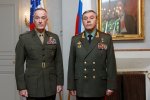That’s not how I’m assessing their competence or readiness. They are objectively awful in the tactical arena.don't like to play by the normal rules of the road
-
Please take a moment and update your account profile. If you have an updated account profile with basic information on why you are on Air Warriors it will help other people respond to your posts. How do you update your profile you ask?
Go here:
Edit Account Details and Profile
You are using an out of date browser. It may not display this or other websites correctly.
You should upgrade or use an alternative browser.
You should upgrade or use an alternative browser.
USS Fitzgerald collision in C7F
- Thread starter Ken_gone_flying
- Start date
That’s not how I’m assessing their competence or readiness. They are objectively awful in the tactical arena.
I would be wary of making that declarative a judgment, especially since we haven’t engaged in direct combat with them and they have accomplished many of their military objectives in Syria. It may not be all that pretty watching them run towards the finish line but they often still get there and they are learning along the way, much as we did in the past 20-something years of conflicts.
Frankly, Flash, you have zero experience with this aspect of their operations. I'm not offering a strategic analysis of the Russian military writ-large. I'm offering my personal, albeit anecdotal, observations about their tactical abilities after operating in their midst.I would be wary of making that declarative a judgment, especially since we haven’t engaged in direct combat with them and they have accomplished many of their military objectives in Syria. It may not be all that pretty watching them run towards the finish line but they often still get there and they are learning along the way, much as we did in the past 20-something years of conflicts.
You can be wary all you want from your vantage point behind a desk.
Frankly, Flash, you have zero experience with this aspect of their operations. I'm not offering a strategic analysis of the Russian military writ-large. I'm offering my personal, albeit anecdotal, observations about their tactical abilities after operating in their midst.
You can be wary all you want from your vantage point behind a desk.
Even from behind a desk I am not uaware of our interactions we have had with the Russians, in addition to alI the other info out there.
I would again be cautious making such sweeping judgements of the state of Russian tactics and compentence from personal anecdotal observations.
Tend to agree with the guy in the back seat of a Growler about Russian tactics (read about the East German Luftwaffe integrating with the West German Luftwaffe), Getting back to the topic...........is the SWO culture on CVs/LHDs different from from the rest of the surface force?
Tend to agree with the guy in the back seat of a Growler about Russian tactics (read about the East German Luftwaffe integrating with the West German Luftwaffe), Getting back to the topic...........is the SWO culture on CVs/LHDs different from from the rest of the surface force?
Yes.
That’s like asking if C-2 culture is different from F/A-18 culture.
VADM Brown (SURFOR) dropped this today:
Surface warfare: A running fix
Of note:
Surface warfare: A running fix
Of note:
To build officers immediately ready to stand watch, we will augment the recently re-established nine-week Basic Division Officer Course (BDOC) with a rigorous six-week Officer of the Deck (OOD) bridge watch standing course centered on International Convention on Standards of Training and Watchkeeping (STCW) requirements. A second phase three-week OOD course will be attended prior to commencing the Advanced Division Officer Course (ADOC) focusing on Bridge Resource Management (BRM) and team building. This course must be passed in order to continue to a fleet-up tour on the same ship or a second division officer tour. Taken together, this new training model will increase formal schoolhouse instruction for first and second tour division officers from 14 weeks to 23 weeks.
Beyond simply increasing the amount of training, we are purposefully re-evaluating the content and quality of the courses, as well. Improvements include inserting operational risk management (ORM) education at every training milestone; defining requalification requirements due to reassignment or shipboard reconfigurations; and augmenting yard patrol craft employment in all officer accession programs. Moreover, better simulations will inject shipboard emergencies, changing environmentals (to include low visibility), and high-density shipping into shiphandling scenarios. Deliberate instruction and targeted feedback will accelerate the learning cycle. And additional assessments at each milestone serve as “force multipliers” and will ensure every minute of training is spent preparing these junior officers for the challenging conditions they can expect to face. These courses are difficult — not all will pass. Standing watch at sea in crowded shipping lanes is hard, but maneuvering the ship with missiles inbound in high-end combat is harder so we must be “brilliant at the basics.”
Amazing. The community is going to introduce a basic course designed to align professional ship drivers with the established international standard. Of course, that instruction is only six weeks long...but hey, progress.
The difference between the aviation and surface community is that my professional military training enables me to meet both federal and international standards.
The difference between the aviation and surface community is that my professional military training enables me to meet both federal and international standards.




